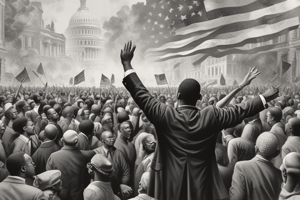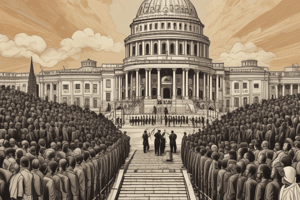Podcast
Questions and Answers
How did the Cold War influence the Civil Rights Movement in the United States?
How did the Cold War influence the Civil Rights Movement in the United States?
- Increased military spending during the Cold War diverted resources away from civil rights initiatives.
- The anti-communist sentiment of the Cold War era directly suppressed civil rights activism.
- The US government feared that racial inequality would be exploited by the Soviet Union as propaganda. (correct)
- The economic boom of the Cold War era diminished the urgency for civil rights reforms.
What was the primary legal basis for challenging segregation in the courts during the Civil Rights Movement?
What was the primary legal basis for challenging segregation in the courts during the Civil Rights Movement?
- The Fourteenth Amendment's equal protection clause. (correct)
- The Second Amendment's right to bear arms for self-defense.
- The Tenth Amendment's reservation of powers to the states.
- The First Amendment's guarantee of freedom of assembly.
Which strategy employed during the Civil Rights Movement aimed to disrupt the status quo through nonviolent means, forcing a response from segregationists and gaining national attention?
Which strategy employed during the Civil Rights Movement aimed to disrupt the status quo through nonviolent means, forcing a response from segregationists and gaining national attention?
- Political lobbying in state legislatures.
- Seizing federal buildings.
- Armed self-defense.
- Economic boycotts and sit-ins. (correct)
How did the Supreme Court's decision in Brown v. Board of Education (1954) influence governmental actions regarding civil rights?
How did the Supreme Court's decision in Brown v. Board of Education (1954) influence governmental actions regarding civil rights?
What was a significant long-term impact of the Civil Rights Act of 1964?
What was a significant long-term impact of the Civil Rights Act of 1964?
Flashcards
Civil Rights Act of 1964
Civil Rights Act of 1964
A pivotal piece of legislation outlawing discrimination based on race, color, religion, sex, or national origin.
Civil Rights Movement
Civil Rights Movement
Collective efforts by African Americans and their allies to dismantle legal segregation and achieve equal rights.
Civil Rights Organizations
Civil Rights Organizations
Groups such as the NAACP and SNCC that organized and led various civil rights campaigns and initiatives.
Protest Movements
Protest Movements
Signup and view all the flashcards
Civil Actions
Civil Actions
Signup and view all the flashcards
Study Notes
- Analysis covers key events, ideals, documents, and organizations in the struggle for African-American civil rights.
- World War II and the Cold War significantly impacted the movement.
- Responses to Supreme Court decisions and governmental actions require examination.
- The Civil Rights Act of 1964 marks a pivotal moment.
- Protest movements are a key area of focus.
- Organizations played a key role.
- Civil actions happened throughout the Civil Rights Movement.
Studying That Suits You
Use AI to generate personalized quizzes and flashcards to suit your learning preferences.




